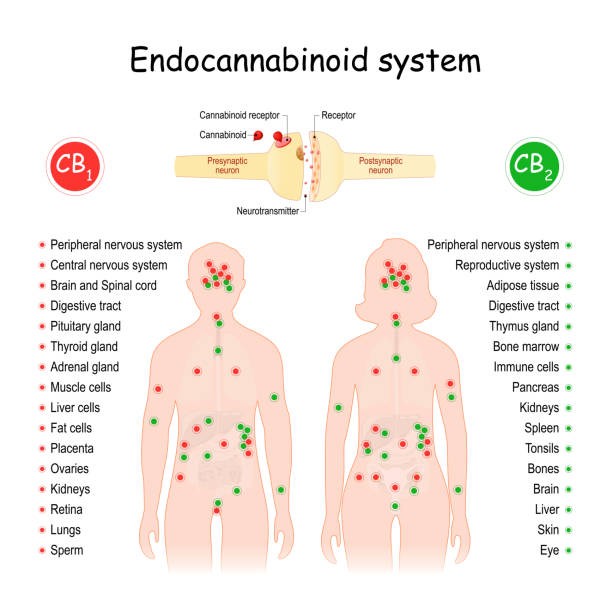Cannabinoids are a group of compounds that interact with the endocannabinoid system in the human body. The endocannabinoid system (ECS) is a complex cell-signaling system that regulates various physiological and cognitive processes. It is composed of endocannabinoids, receptors, and enzymes that are involved in the synthesis and degradation of these compounds. The ECS plays a crucial role in maintaining homeostasis in the body and is involved in various diseases such as chronic pain, inflammation, anxiety, and depression. This article will provide an in-depth overview of cannabinoids in the human body, including their effects on the ECS, their potential therapeutic applications, and the current state of research in this field.
What are cannabinoids?
Cannabinoids are a group of compounds that are primarily found in the cannabis plant (Cannabis sativa). They are classified into three main categories: phytocannabinoids, endocannabinoids, and synthetic cannabinoids. Phytocannabinoids are naturally occurring compounds found in the cannabis plant, such as tetrahydrocannabinol (THC) and cannabidiol (CBD). Endocannabinoids are produced naturally in the body and include anandamide and 2-arachidonoylglycerol (2-AG). Synthetic cannabinoids are created artificially and are designed to mimic the effects of phytocannabinoids.
How do cannabinoids interact with the endocannabinoid system?
The ECS is a complex cell-signaling system that plays a crucial role in regulating various physiological and cognitive processes in the body. It is composed of endocannabinoids, receptors, and enzymes that are involved in the synthesis and degradation of these compounds. The two main receptors in the ECS are the CB1 receptor and the CB2 receptor. The CB1 receptor is primarily found in the central nervous system and is involved in the regulation of pain, appetite, and mood. The CB2 receptor is primarily found in the immune system and is involved in the regulation of inflammation and immune function.
When cannabinoids enter the body, they interact with the CB1 and CB2 receptors in the ECS. Phytocannabinoids such as THC and CBD can bind to these receptors and activate them, leading to various physiological and cognitive effects. Endocannabinoids such as anandamide and 2-AG are produced naturally in the body and bind to these receptors to regulate various physiological processes. The enzymes responsible for the synthesis and degradation of endocannabinoids are also part of the ECS and play a crucial role in maintaining the balance of these compounds in the body.
What are the potential therapeutic applications of cannabinoids?
Cannabinoids have been studied extensively for their potential therapeutic applications in various diseases and conditions. THC, the primary psychoactive compound in cannabis, has been used for its analgesic properties in the treatment of chronic pain. It has also been used for its antiemetic properties in the treatment of nausea and vomiting associated with chemotherapy. CBD, on the other hand, has been studied for its potential therapeutic applications in various conditions such as anxiety, depression, and epilepsy.
In addition to THC and CBD, other phytocannabinoids such as cannabigerol (CBG) and cannabichromene (CBC) have also been studied for their potential therapeutic applications. CBG has been studied for its anti-inflammatory properties and its potential in the treatment of inflammatory bowel disease. CBC has been studied for its potential in the treatment of pain and inflammation.
Endocannabinoids such as anandamide and 2-AG have also been studied for their potential therapeutic applications. Anandamide has been studied for its potential in the treatment of anxiety and depression. 2-AG has been studied for its potential in the treatment of inflammation and pain.
What is the current state of research in this field?
Despite the potential therapeutic applications of cannabinoids, research in this field is still in its early stages, and more research is needed to fully understand the effects of cannabinoids on the human body. The legal status of cannabis in many countries has also hindered research in this field.
Several clinical trials have been conducted to study the potential therapeutic applications of cannabinoids in various diseases and conditions. For example, a randomized, double-blind, placebo-controlled trial conducted in 2018 found that CBD significantly reduced the frequency of seizures in patients with Dravet syndrome, a rare form of epilepsy. Another randomized, double-blind, placebo-controlled trial conducted in 2019 found that THC and CBD combined were more effective than THC alone in reducing pain in patients with chronic pain.
However, the results of clinical trials have been mixed, and more research is needed to determine the optimal dosage and administration of cannabinoids for specific diseases and conditions. In addition, the long-term effects of cannabinoids on the human body are still unknown, and more research is needed in this area as well.
Conclusion
Cannabinoids are a group of compounds that interact with the endocannabinoid system in the human body. The ECS plays a crucial role in maintaining homeostasis in the body and is involved in various diseases such as chronic pain, inflammation, anxiety, and depression. Cannabinoids have been studied extensively for their potential therapeutic applications in various diseases and conditions. THC and CBD are the most well-known cannabinoids and have been studied for their potential therapeutic applications in various conditions. However, more research is needed to fully understand the effects of cannabinoids on the human body, and the legal status of cannabis in many countries has hindered research in this field. Despite these challenges, the potential therapeutic applications of cannabinoids continue to be studied, and it is likely that more research in this field will lead to the development of new treatments for various diseases and conditions.



